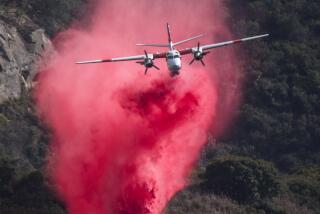War Birds Come Home to Roost in Arizona Thanks to ‘Peace Dividend’ : Aircraft: More than 4,000 planes that once flew missions over Korea, Vietnam and Iraq are at Davis-Monthan Air Force Base, awaiting new homes or the scrap heap.
TUCSON — They appear like a mirage in the shimmering Arizona heat, these rows of bandaged war birds roosting in the desert.
Swathed in a white preservative coating to protect them against the sun, more than 4,000 aircraft that once flew missions over Korea, Vietnam and Iraq have landed here at Davis-Monthan Air Force Base, many for the last time.
Some may see combat again. Others will be sold to foreign governments, turned into scrap or cannibalized for their parts.
The saddest fate awaits the once-mighty B-52 bombers, nuclear backbone of the now-defunct Strategic Air Command. In compliance with the Strategic Arms Reduction Treaties, 352 of them will be chopped into three sections and consigned to junk dealers.
The base’s Aerospace Maintenance and Regeneration Center, which oversees these activities, is the only facility of its kind in the United States. It has never been busier.
“The ‘peace dividend’ has contributed a dramatic increase in surplus aircraft,” said the center’s commander, Col. Bruce Rianda. “Last year 996 came in, the highest number since the end of the Vietnam War. This year we’re looking at 700 or 800 more airplanes showing up. We currently have about 4,200 stored on the base.”
Plenty of emotion rides in with the retiring craft. Pilots and crews willingly tell anyone who will listen how dependable their planes were.
“One jet came in here from the Ohio Air National Guard, and the whole unit had signed the sides of the aircraft, which was also decorated with pictures of their kids,” Rianda recalls.
Veterans often drop by, looking for their old reliables. “Some are choked up,” he said, “and they want us to drop everything and take them out so they can spend a few minutes alone with their old planes. But we just don’t have the resources to do that.”
All the armed forces, including the Coast Guard, rely on the Arizona center both for spare parts and storage of their aircraft. “We are the sole source for a lot of parts, and that is by far our biggest function,” Rianda said.
“For instance, if we had to go to a contractor to retool a hydraulic pump for an older aircraft still on duty, it would cost a lot of money, but we can keep the price at a minimum. Last year we sent out parts worth $125 million.”
Operation Desert Storm, the 1991 Persian Gulf War, tapped the center for more than 1,500 parts. “Among the items in demand was the C-130 propeller,” Rianda said. “There was a real problem over there with dust and dirt fouling up the transports’ props.”
But it’s usually surplus aircraft, not parts, that lure foreign buyers to this second-hand jet lot. The newest aircraft in residence, nine sleek F-16 Fighting Falcons, soon will be sold to Pakistan.
Other countries, including Thailand, Greece, Argentina and Turkey, are snapping up A-7 Corsairs and A-10 Warthogs, slightly older attack aircraft. “Some Navy P-3 anti-submarine craft are also prime candidates for sales to Chile, Australia and Thailand,” said Jerry Fugere, the base’s marketing analyst.
And there is a continuing interest in the F-4 Phantom, a stalwart in Vietnam that is still flown in many countries. More than 1,000 F-4 fighters, some with red stars on their fuselages denoting MIG kills over Vietnam, constitute the largest number of aircraft at the base.
Starting next year, as many as 400 F-4s will be used as unmanned target drones by U.S. pilots in more advanced aircraft and by ground-based missile crews.
Some aircraft leave the military for a productive civilian life. At least 41 propeller-driven observation planes whose crews once ferreted out enemy troops in Vietnam will be used to search for animal poachers and illegal fishing trawlers in several African countries.
Other surplus aircraft are helping put out forest fires, searching U.S. borders for illegal immigrants and hauling logs for timber companies.
“We buy some of these airplanes that look like total derelicts and restore them for wealthy people who like expensive toys to play with,” said John R. Gasho, who heads Western International Aviation, an aircraft restoration company in Tucson.
“We’ll totally rehaul this hulk, put on new props, instrumentation and electronics and make it into a marvelous plaything,” Gasho said of an old Navy amphibious plane he acquired from Davis-Monthan.
“We just finished one about six months ago for a neurosurgeon who uses it on fishing expeditions. Another fellow’s touring his around Europe and Africa.”
A slow economy has dampened the U.S. luxury-airplane business, but Gasho hopes that foreign buyers interested in old military cargo planes will keep his business thriving. “They’ll take an airplane that’s not licensable here in the United States and use it in a Third World country to haul cargo,” he said.
Even if business is slow, scrap dealers around the base always manage to find something of interest. Take the silver wire in the doomed B-52s, for instance.
“It’s just not economical for us to remove it,” said Rianda. “But those dealers with the time can find and melt down seven miles of silver wire from that plane.”
More to Read
Sign up for Essential California
The most important California stories and recommendations in your inbox every morning.
You may occasionally receive promotional content from the Los Angeles Times.










